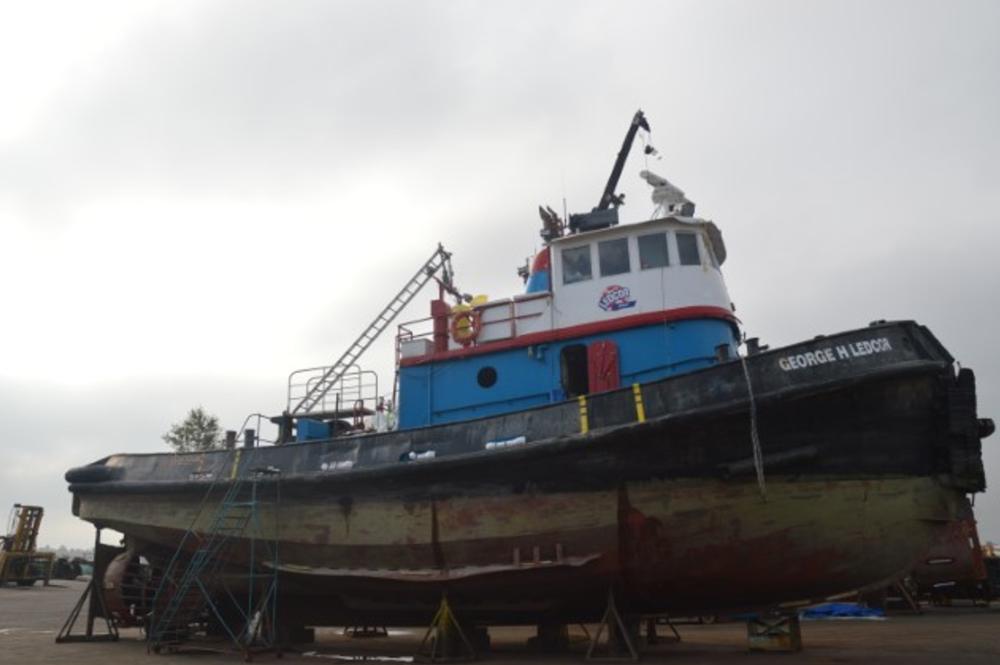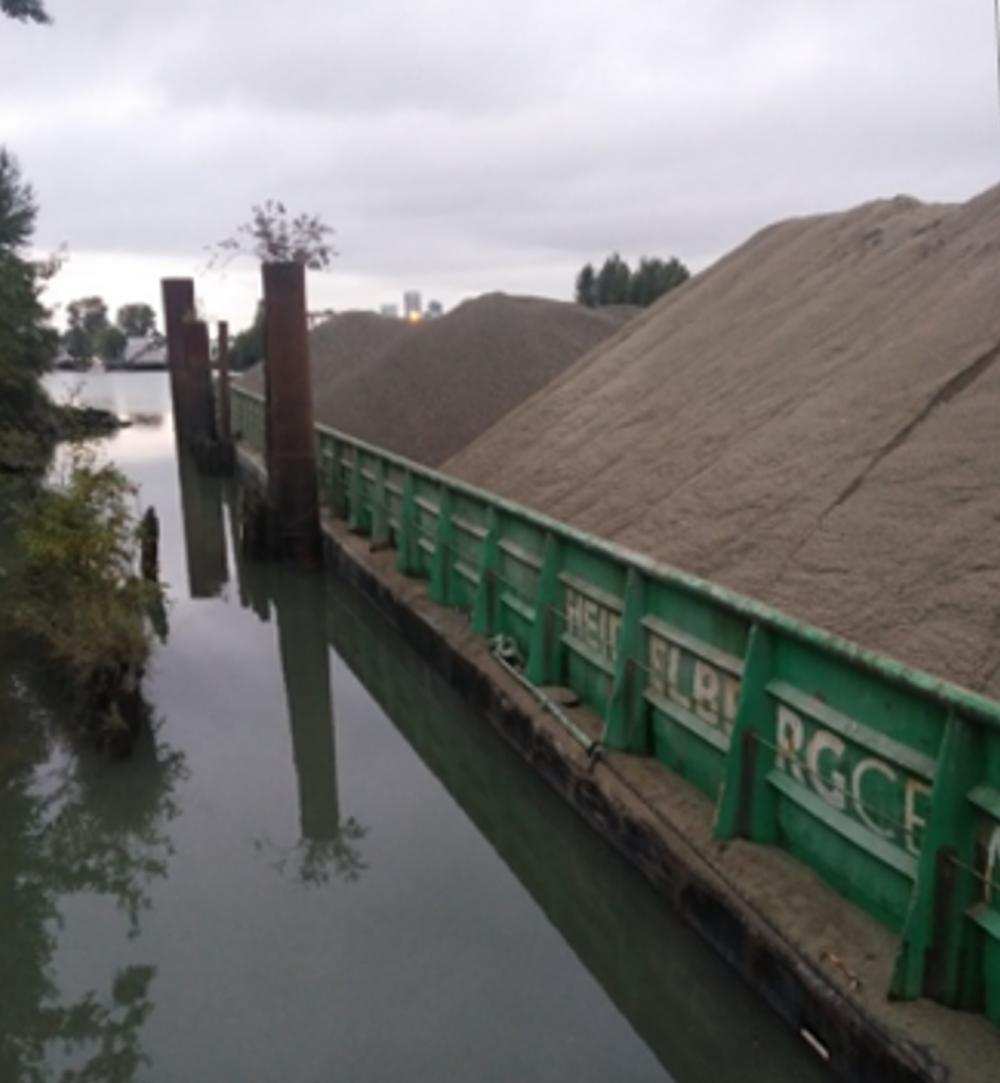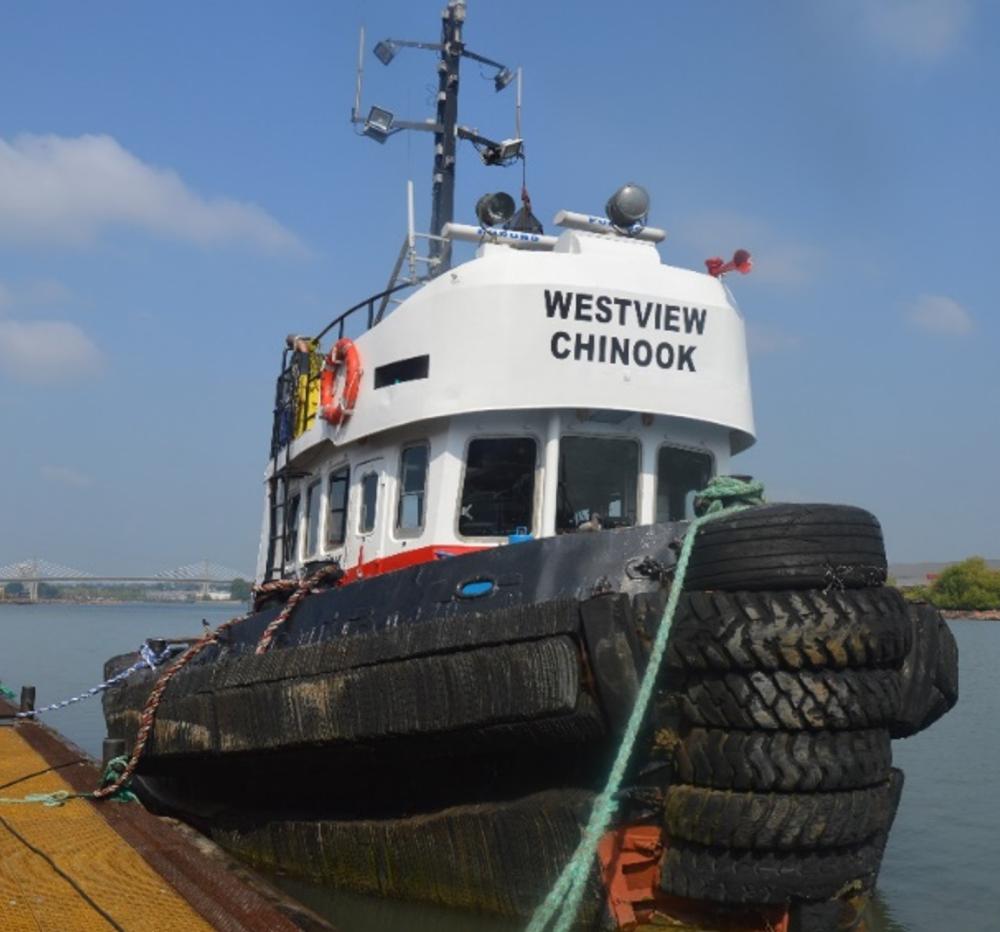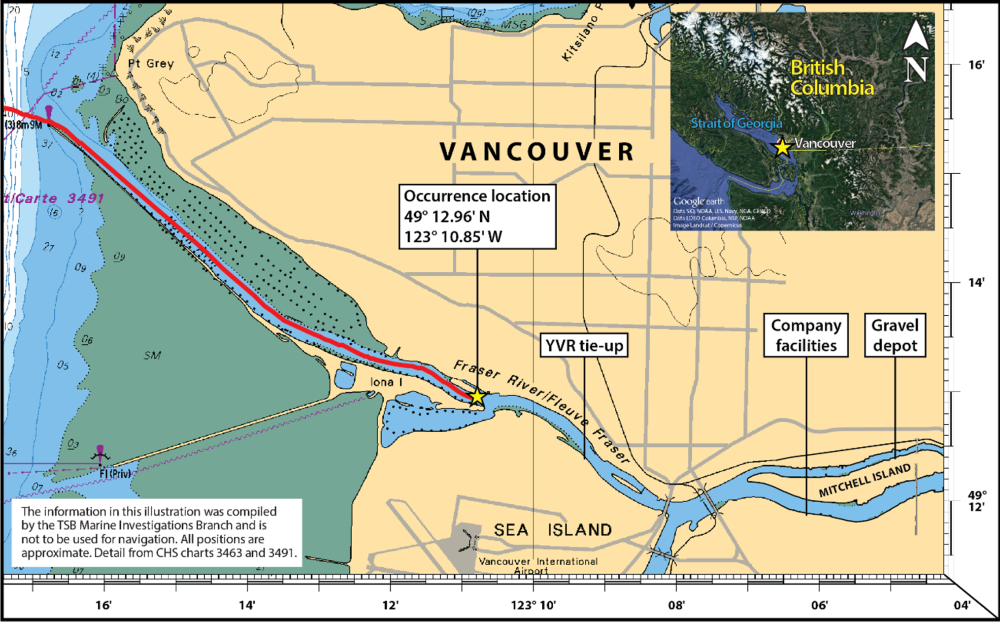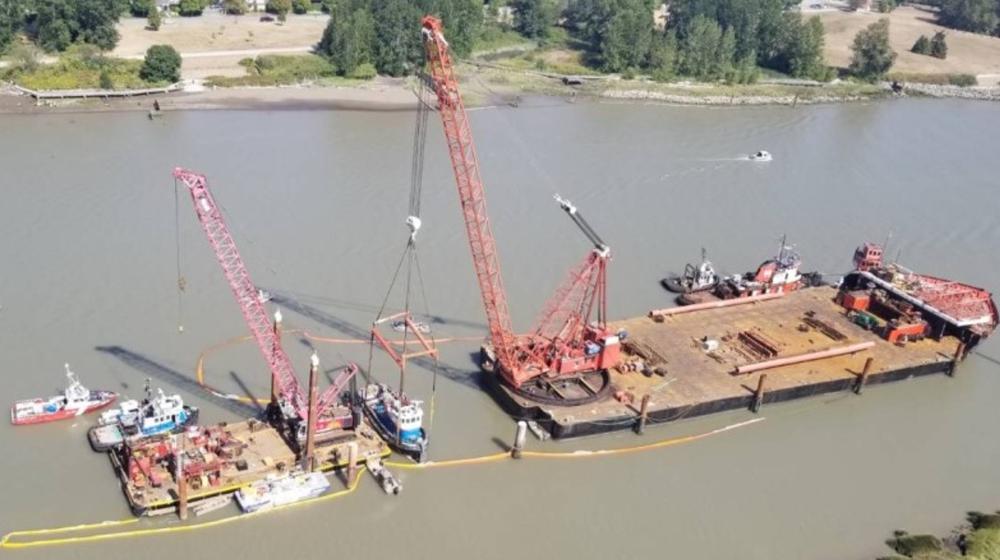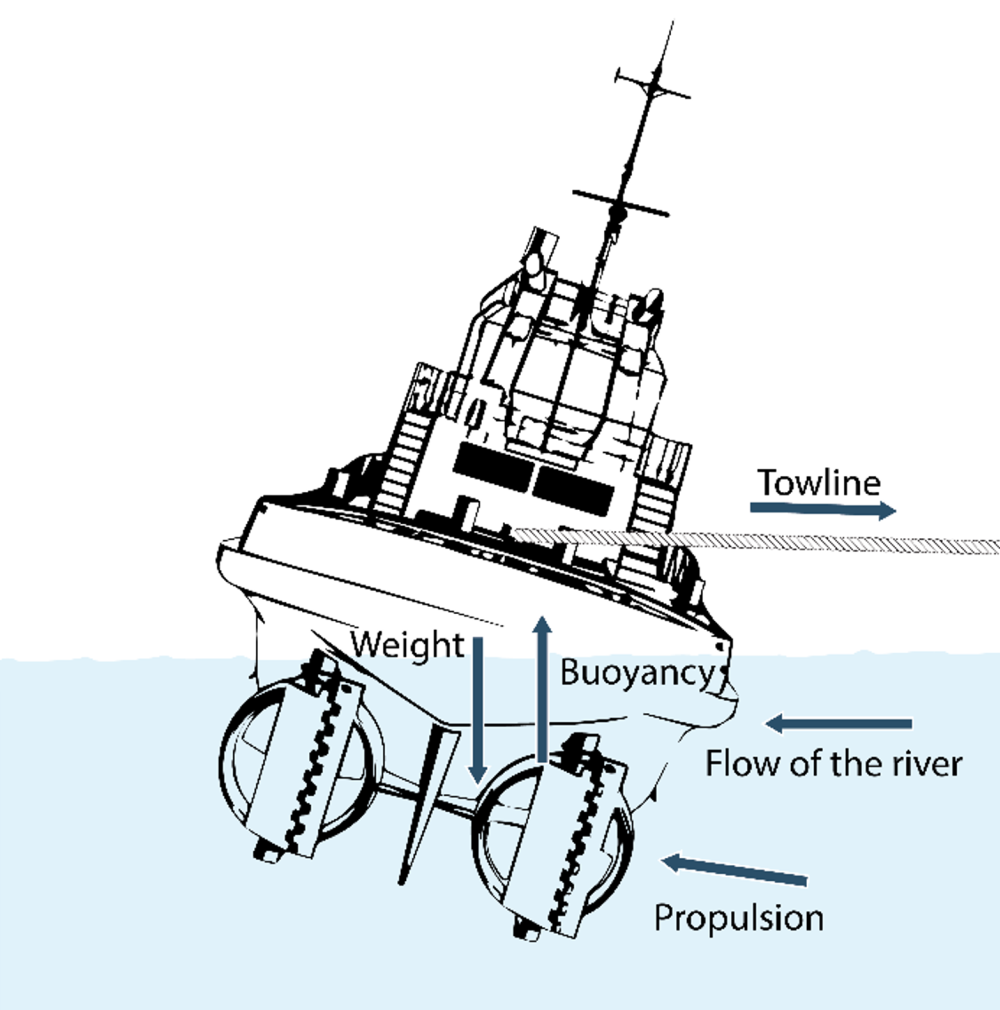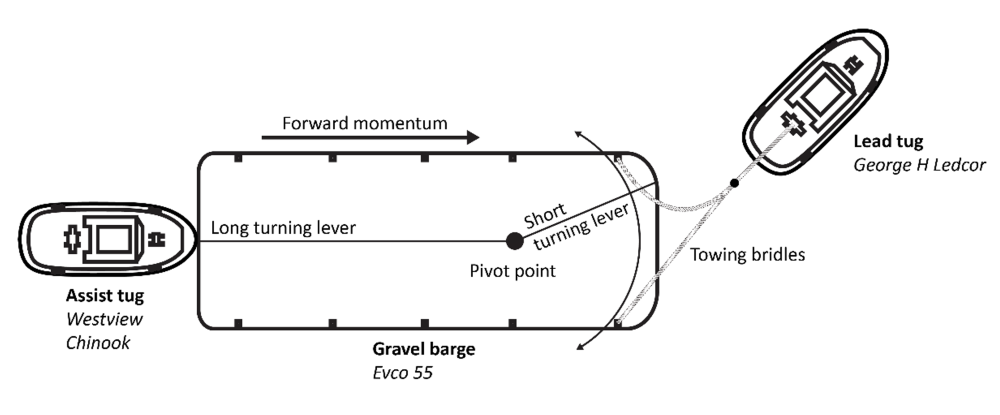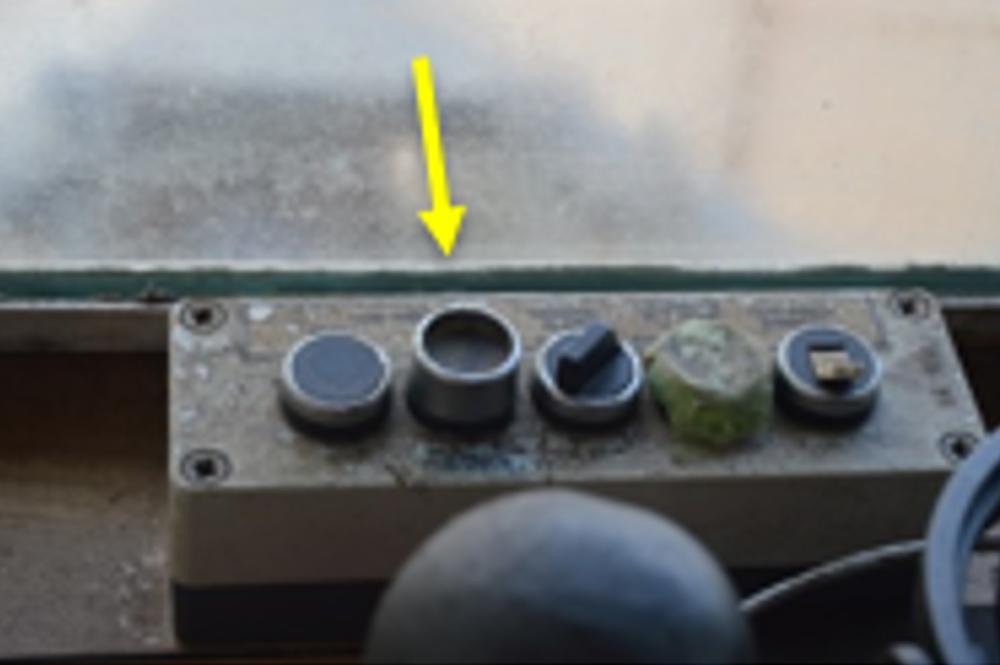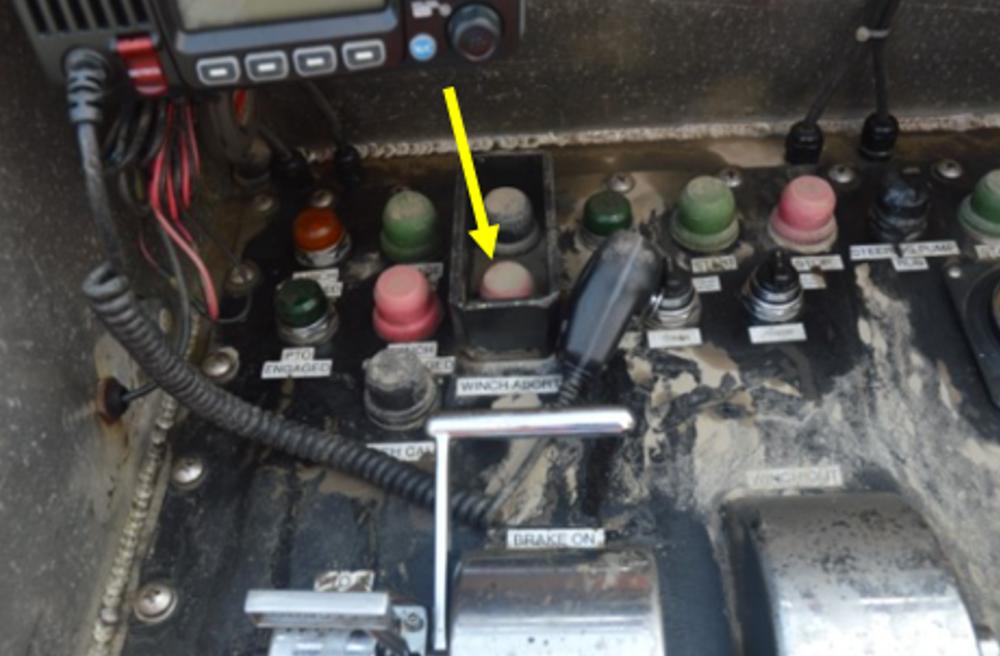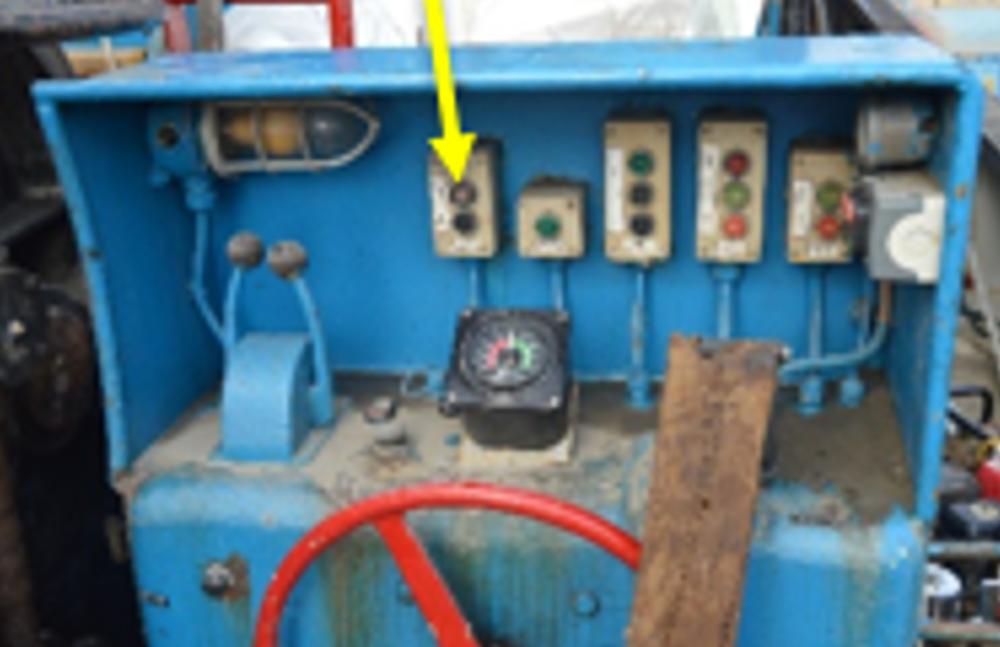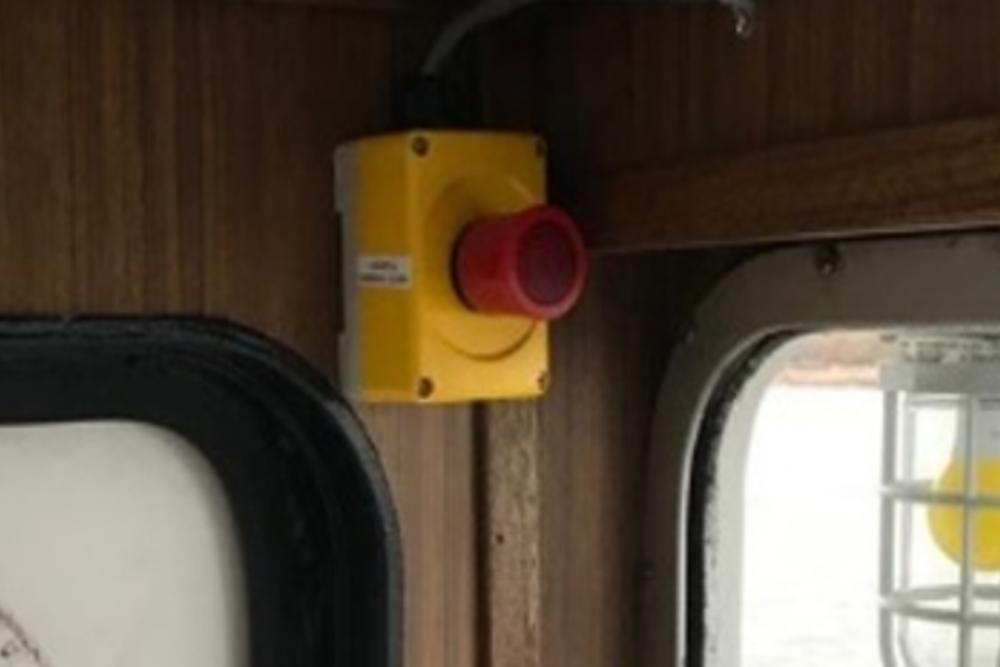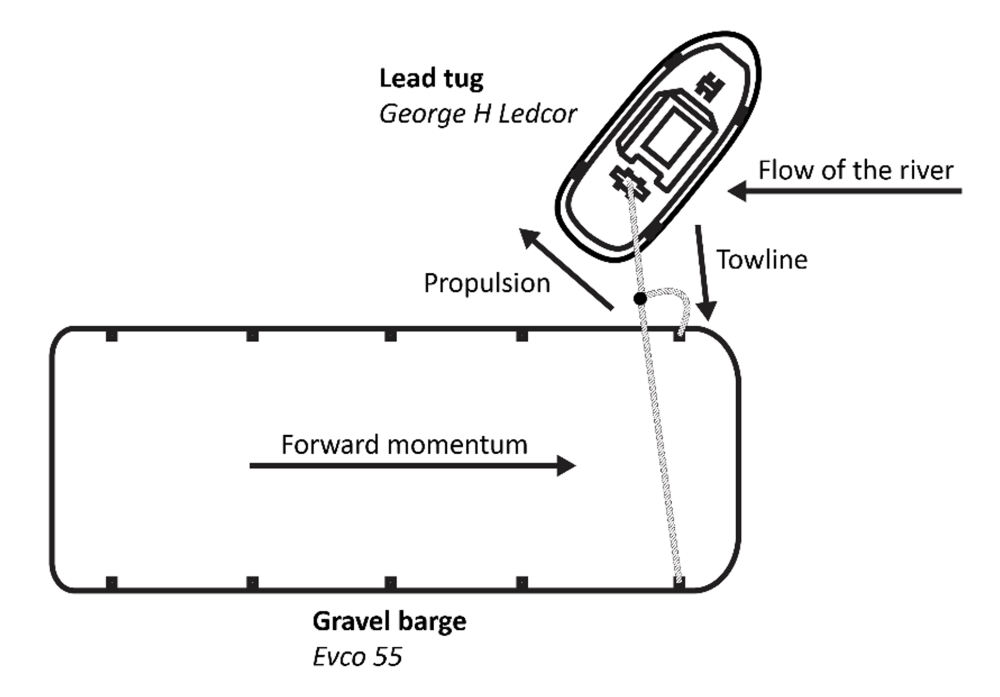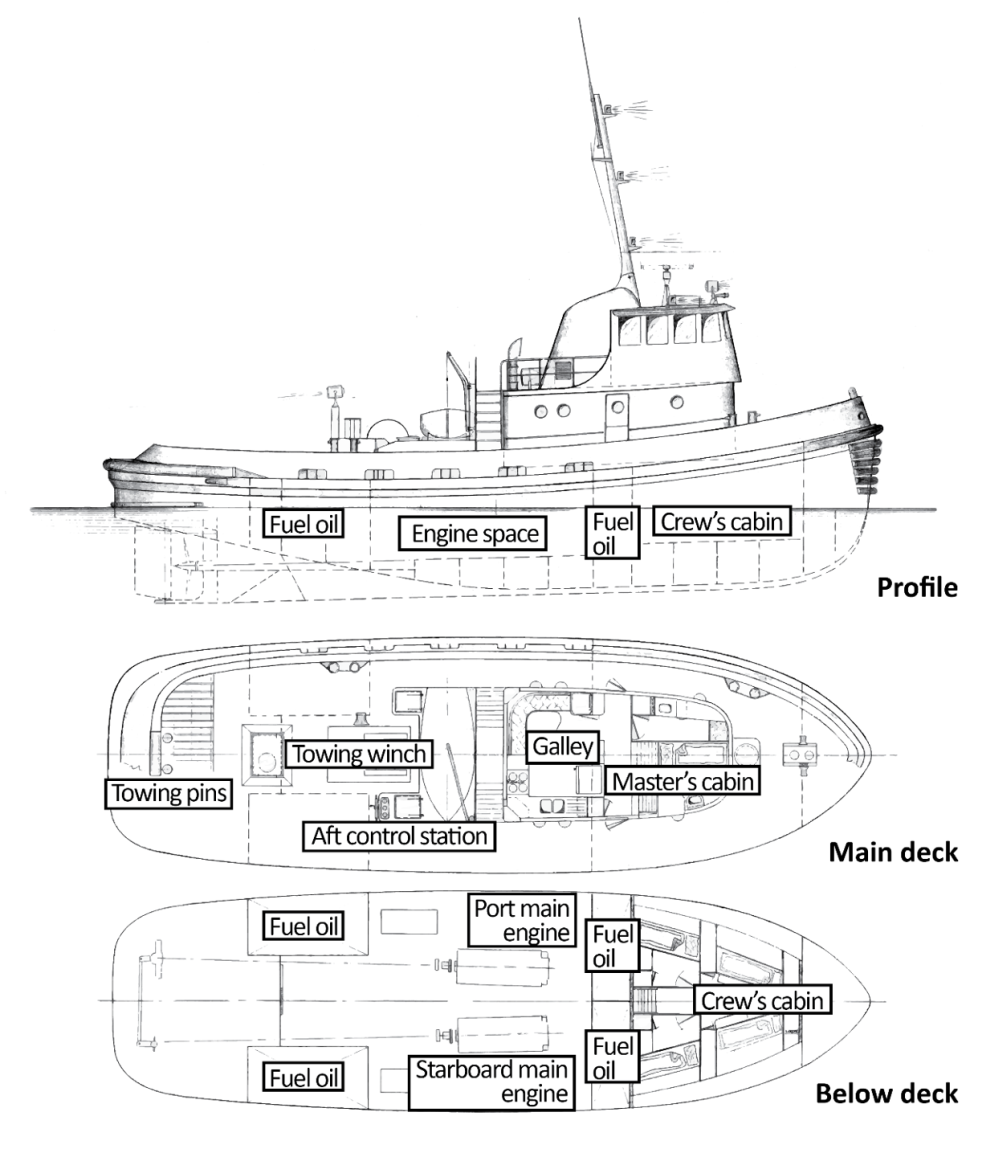Capsizing
Tug George H Ledcor
Fraser River, British Columbia
The Transportation Safety Board of Canada (TSB) investigated this occurrence for the purpose of advancing transportation safety. It is not the function of the Board to assign fault or determine civil or criminal liability. This report is not created for use in the context of legal, disciplinary or other proceedings. See Ownership and use of content. Masculine pronouns and position titles may be used to signify all genders to comply with the Canadian Transportation Accident Investigation and Safety Board Act (S.C. 1989, c. 3).
Summary
On 13 August 2018, the tug George H Ledcor was towing the loaded gravel barge Evco 55, with the assist tug Westview Chinook pushing to an unloading facility on Mitchell Island in the north arm of the Fraser River, British Columbia (BC). At approximately 2210, the George H Ledcor girded and capsized after being overtaken by the barge. The 4 crew members on board were rescued from the tug's overturned hull by the nearby yarding tug River Rebel and the assist tug Westview Chinook. One crew member sustained a serious injury to his hand. The assist tug then towed the overturned tug and barge to a nearby tie-up, where a pollution boom was deployed around the tug. An unknown quantity of diesel fuel was released as a result of the occurrence.
1.0 Factual information
1.1 Particulars of the vessels
| Vessel name | George H Ledcor | Evco 55 | Westview Chinook |
|---|---|---|---|
| Official number | 320352 | 810461 | 396178 |
| Port of registry | New Westminster | Vancouver | Nanaimo |
| Flag | Canada | Canada | Canada |
| Gross tonnage | 81.41 | 2275.33 | 52.50 |
| Length | 19.29 m | 78.03 m | 13.47 m |
| Built | 1964 | 1988 | 1981 |
| Propulsion | 2 diesel engines of 567 kW (in total) driving twin-screw fixed-pitch propellers | Non-propelled | 2 diesel engines of 701 kW (in total) driving twin-screw fixed-pitch propellers |
| Cargo | none | 4621 tonnes of gravel | none |
| Crew | 4 | unmanned | 2 |
| Registered owner | Ledcor Resources and Transportation Inc. | Lehigh Hanson Materials Limited | Pacific Towing Services Ltd.* |
* At the time of the occurrence, the Westview Chinook was leased to Ledcor Resources and Transportation Inc.
1.2 Description of the vessels
1.2.1 George H Ledcor
The George H Ledcor (Figure 1) was a conventional coastal tug of steel construction used primarily for river and coastal towing. The general arrangement of the vessel is shown in Appendix A. The deckhouse, located on the fore part of the main deck, was fitted with watertight doors on both the port and the starboard sides. The main deck had 3 watertight hatches leading to the machinery and the crew's cabin located below deck. The crew's cabin was located forward in the forecastle and could accommodate 4 crew.
The wheelhouse was located on top of the deckhouse and accessed via stairs that led up from the deckhouse to a door on the aft port side of the wheelhouse. The wheelhouse had windows facing forward and to either side, and 2 windows facing aft. The wheelhouse contained a conning station with controls for the main engines and steering. The vessel was equipped with 2 other conning stations: 1 on the upper aft deck and 1 on the main deck.
The vessel was equipped with an automatic identification system that provides the vessel's identity, type, position, course, speed, and navigational status and enables the vessel to be tracked by other vessels and by Vessel Traffic Services.
A hydraulically driven towing winch was located on the aft portion of the main deck. Each conning station contained an abort mechanism with a button that could be pressed to release the winch brake and immediately release the tension in the towline, and another button to reset the winch brake. The winch was also fitted with a brake release switch, which allowed for immediate or controlled release of the towline. The tug had towing pinsFootnote 1 located at the stern.
1.2.2 Evco 55
The Evco 55 (Figure 2) is a flat-decked, non-propelled barge of steel construction with a cargo capacity of 5800 tonnes. The barge was loaded with 4621 tonnes of gravel and trimmed evenly with a draft of approximately 4.7 m at the time of the occurrence.
1.2.3 Westview Chinook
The Westview Chinook (Figure 3) is a tug of steel construction used mostly for yarding operations. The wheelhouse is located on the fore part of the main deck. There are 3 conning stations with steering and engine controls: 1 inside the wheelhouse, 1 atop the wheelhouse, and 1 on the starboard side of the winch on the aft part of the main deck. At the time of the occurrence, the tug was being used to push the Evco 55.
1.3 History of the voyage
On 13 August 2018, just after midnight,Footnote 2 a crew of 4 arrived at the Ledcor Resources and Transportation Inc. (Ledcor) facility in Richmond, BC, to begin their shift. The master, mate, and 2 deckhands boarded the George H Ledcor and prepared the tug to operate between the Fraser River and Sechelt, towing gravel barges to and from various locations in the Fraser River.
The mate completed all of the required checklists prior to departure, and checked and tested the tug's abort mechanisms. The crew then conducted a pre-trip meeting. At approximately 0100, the George H Ledcor departed the Richmond facility to pick up the Evco 55 in Surrey.
At around 0400, the George H Ledcor arrived in Surrey, and the mate and one of the deckhands prepared the Evco 55 for towing. By 0525, the tug and barge had departed for Sechelt. The transit from Surrey to Sechelt was uneventful, and the tug and barge moored at the loading facility in Sechelt at 1319. The mate and the deckhand monitored the loading of 4621 tonnes of gravel onto the barge. There was a delay in loading, and the departure from Sechelt was delayed as well. The tug and barge departed Sechelt at 1645.
At 1800, as the George H Ledcor was pulling the Evco 55 using approximately 80% throttle and making way at around 5 knots, the master took over the watch from the mate. The master arranged to have an assist tug,Footnote 3 the Westview Chinook, meet up with the George H Ledcor and begin pushing the Evco 55 to arrive at Mitchell Island close to high water slack.Footnote 4 The assist tug joined the tug and barge and began pushing at approximately 2045. Pushing the barge increased its speed by approximately 1 knot.
Just before entering the north arm of the Fraser River (Figure 4) at about 2100, the Westview Chinook stopped pushing to allow the crew of the George H Ledcor to shorten up the towline so that the distance between the tug and the barge was approximately 15 m. Once the towline was shortened, the tug and barge entered the river, and the Westview Chinook began to push again. At some point before entering the river, the crew had closed the watertight doors and hatches on the George H Ledcor in accordance with Ledcor's safe work practices.
There are a series of natural bends between the entrance to the river and the gravel depot on Mitchell Island. At 2148, the tug and barge navigated the first of these bends, then navigated the second bend a few minutes later. The tug and barge approached the third bend, which was slightly larger, at a speed of 6 knots. At 2208, the master initiated a course alteration of 31° to port. Within a minute, the master on the George H Ledcor noticed that the barge was not responding to the course alteration. He then called the master on the Westview Chinook by very high frequency radiotelephone and told him to stop pushing the barge, which he then did. The master on the George H Ledcor then applied more port rudder, but the barge continued on a straight course.
The towline connecting the George H Ledcor and the Evco 55 pulled over to the tug's starboard side as the barge began to overtake the tug, which caused the tug to develop a starboard heel and placed it in a girded position.Footnote 5 The master attempted to reposition the tug in front of the barge by increasing the throttle to full and applying full starboard rudder. This action increased the starboard heel of the tug.
At this time, the Westview Chinook attempted to contact the George H Ledcor but did not receive a response. The Westview Chinook then began proceeding towards the George H Ledcor to assess the situation.
As the starboard heel continued to increase, the George H Ledcor's bulwarks became submerged, and the tug began to capsize. The master attempted to activate the abort mechanism in the wheelhouse and release the tow, but the abort button was located on the port side of the conning station and he was unable to reach it owing to the vessel's heel. He then shouted to the deckhand to abort the tow. The deckhand left the wheelhouse and went to the aft conning station directly behind the wheelhouse to abort the tow. Once there, the deckhand pushed a button on the conning station, but the towline did not release. Shortly after, the master joined the deckhand at the aft conning station as the tug continued to roll over. The master attempted to release the winch brake while also trying to maintain his balance, but the towline still did not release.Footnote 6
As the tug was rolling over, it paused briefly at a 90° angle, which allowed the mate and the deckhand, who had been sleeping in the accommodation space below, to escape by climbing out the port side deckhouse door. They joined the master and deckhand on the side of the hull.
At 2210, in position 49°12.96′ N, 123°10.85′ W, the tug rolled completely upside down. All 4 of the crew managed to climb onto the overturned hull. One of the deckhands sustained a serious injury to his hand while attempting to climb onto the barge from the tug.
The Westview Chinook arrived when the George H Ledcor was alongside the barge with the tug's bow facing the barge's stern, and rescued the master and mate from the hull. The crew on a nearby yarding tug, the River Rebel, who had observed the girding, arrived on scene, rescued the deckhands, and transferred them to the Westview Chinook. The crews of the Westview Chinook and the River Rebel secured the capsized George H Ledcor and the Evco 55 together. The Westview Chinook crew then attached their tow bridles to the barge and proceeded to tow the capsized tug and barge up the river to the YVR tie-up.
1.4 Spill response and tug salvage
As the capsized tug and barge were being towed to the YVR tie-up, the master on the Westview Chinook contacted Ledcor's operations manager and Marine Communications and Traffic Services to notify them of the situation. Marine Communications and Traffic Services then notified the Canadian Coast Guard (CCG) Environmental Response duty officer, and Ledcor tasked another tug to pick up a pollution boom and spill response supplies from the Richmond facility and deliver them to the YVR tie-up.
Once the George H Ledcor and the Evco 55 were tied up at approximately 2300, the pollution boom was deployed around the overturned tug. At around 2345, the CCG search and rescue hovercraft Moytel arrived to ensure the safety of the crew. CCG Environmental Response personnel, crews from assisting tugboats, and responders from the Musqueam Indian BandFootnote 7 arrived throughout the night to assist with and monitor the spill response. Ledcor contacted the marine emergency response corporation for the west coast (Western Canada Marine Response Corporation), marine consultants, naval architects, divers, heavy crane service providers, insurance companies, and surveyors to assist with a salvage plan.
On 14 August, a unified command was formed with representatives from the CCG Environmental Response program, the Musqueam Indian Band, the BC Ministry of Environment and Climate Change Strategy, the City of Richmond, and Ledcor Resources and Transportation Inc. The Greater Vancouver Integrated Response Plan was initiated,Footnote 8 at which time multiple other agenciesFootnote 9 became formally involved in the spill response under an incident command system.Footnote 10 Shoreline cleanup assessment technique surveys and a sampling plan were initiated.
On 16 August, the George H Ledcor was refloated (Figure 5) and pumped out to the point where it could be towed to a nearby shipyard and then removed from the river.
At the time of the occurrence, the tug had been carrying approximately 22 000 L of diesel fuel. It was estimated that approximately 800 L of diesel fuel was recovered from the river. An unknown quantity of diesel fuel was pumped out of the tug. It was therefore not possible to determine the exact amount of pollution that resulted from the occurrence. On 17 August, a marine consultant collected soil and water samples from around the occurrence location and identified no recordable contamination. That same day, all resources were stood down.
1.5 Environmental conditions
At the time of the occurrence, there were light winds from the north-northwest at 6 knots, the air temperature was 19 °C, and the water temperature was approximately 18 °C. It was dark, but the skies were clear, aside from some haze from local forest fires.
The north arm of the Fraser River averages about 0.1 nautical miles wide from the entrance up to where the north arm reaches the main river. At the time of the occurrence, it was close to high water in the river and the depth was approximately 12 m. The tide was just at the end of the flood. Given the depth of the water in the river, the George H Ledcor had an approximate underkeel clearance of 9.0 m, and the Evco 55 had an approximate underkeel clearance of 7.3 m.
1.6 Vessel certifications
The George H Ledcor held a valid Ship Inspection Certificate issued in February 2016. As a tug of over 15 gross tonnage (GT), the George H Ledcor was subject to quadrennial inspections by Transport Canada (TC). The last inspection was conducted in 2015.
The George H Ledcor also had a stability booklet that had been approved by TC in 1965. The booklet contained stability guidance for 3 conditions: lightship, deepest departure, and operating.
1.7 Crew certification and experience
The crew held all of the necessary certifications required by the Marine Personnel Regulations.Footnote 11
The master held a valid Master 150 Gross Tonnage, Domestic certificate of competency with a Limited, Contiguous Waters Voyage endorsement. The master had started working in the towing industry in 2000 and had worked as a master for at least 8 years. He had been employed by Ledcor for the last 3 years, and had experience working on the George H Ledcor before the occurrence voyage. In the previous 3 months, he had been master on the Paul C Ledcor,with the same mate conducting similar towing operations.
The deckhand on watch at the time of the occurrence held a Bridge Watch Rating Training Course certificate. The deckhand had been employed full-time with Ledcor for just over 3 years.
The mate, who was off duty at the time of the occurrence, held a valid Watchkeeping Mate, Near Coastal certificate of competency. The mate had over 20 years of marine experience and had served as mate for the last 8 years.
The second deckhand, who was also off duty at the time of the occurrence, had been employed with Ledcor for just over a year.
1.8 Fatigue
Fatigue has been recognized as a factor in many marine accidents. Certain vessel working conditions, such as having a poor sleep environment and doing shiftwork, may increase the risk of fatigue-related accidents. For sleep to be restorative, it should occur at night in a period of at least 7, and up to 9, continuous hours. Footnote 12
The shift-scheduling practice on board the George H Ledcor was to use a 6 hours on, 6 hours off schedule. International researchFootnote 13, Footnote 14, Footnote 15 on shift-scheduling practices for watchkeepers has found that, compared to other schedules, the 6 hours on, 6 hours off schedule is associated with less daily sleep, increased potential for poor-quality fragmented sleep, more frequent episodes of nodding off (microsleeps), and excessive sleepiness—especially during the early morning hours. At the time of the occurrence, the crew of the George H Ledcor were on day 1 of a 7-day continuous voyage. The investigation determined that fatigue was not a factor in this occurrence.
1.9 Damage
After the George H Ledcor was recovered, it was determined that the tugwas still structurally intact, but that electronic navigation equipment, wiring, and machinery had been damaged. The tug was declared a total constructive loss.
1.10 Lifesaving equipment
The George H Ledcor carried all of the required emergency equipment, including life jackets, immersion suits, liferafts, and an emergency position-indicating radio beacon (EPIRB).
The tug had 2 six-person liferafts. Both of the liferafts were equipped with hydrostatic releases. When the tug capsized, the hydrostatic releases functioned as intended. However, 1 liferaft became tangled in the rigging and did not float free. The other liferaft floated to the surface but did not inflate because the tug did not sink deep enough in the water to generate the force necessary to pull on the painter and inflate the liferaft.
The tug had a float-free EPIRB that was secured by means of a hydrostatic release. At the time of the capsizing, the EPIRB floated free but did not send a signal. Following the occurrence, Ledcor examined the EPIRB and determined that it was damaged and water had entered the unit; it is not known when the damage occurred.
1.11 Industry context
Tugs on the west coast of Canada are owned by a variety of entities, from independent masters who own and operate a single tug to large companies, such as Ledcor Resources and Transportation Inc., that operate a fleet of tugs and barges.Footnote 16 Tugs are involved in a variety of operations, including berthing operations for large vessels, coastal towing, log booming, river towing, and yarding operations. Each type of operation is unique and carries its own associated risks. Although girding situations can occur during any type of towing operation, these are more often reported in river towing and yarding operations.
Ledcor Resources and Transportation Inc. is a member of the Council of Marine Carriers. The Council estimates that it represents approximately 60% of the tugs operating on the west coast of BC, which conduct approximately 75% of the towing business in this area. The Council furthers the interests of its members by formulating policies and advocating legislation and regulations that are beneficial to its members, in consultation with appropriate governmental and industrial agencies.Footnote 17
1.12 Guidance to prevent girding
The risk of girding is always present during towing operations and needs to be safely managed. Girding situations can evolve rapidly and leave little opportunity for masters to take corrective action once the situation has developed. It is important, therefore, that measures are taken to reduce the risk of vessel girding and that the factors that can lead to it are recognized early.
To assist tug operators in preventing girding situations, in 1994, TC issued Ship Safety Bulletin 13/1994, “Towboats – Dangers Associated with Girding.” The bulletin was issued as a result of 2 TSB investigationsFootnote 18 into the girding and subsequent capsizing of tugs. The safety bulletin advises of the hazards associated with towing operations, points out the dangers of girding, and strongly urges masters to manage the risk by adopting any practical measures that might prevent their vessel from being placed in a girding situation. It also reminds masters to ensure that the manoeuvrability of the tow is not compromised by its weight and momentum. The bulletin highlights that girding situations can arise rapidly, preventing crew members from being able to activate the abort mechanism, don lifesaving equipment, send a distress call, or warn others of the imminent situation.
In 2014, TC produced an educational video entitled “My Vessel My Responsibility - Tow Boats,”Footnote 19 which includes a discussion of the risks associated with girding. The video emphasizes the importance of staying alert, being aware of current environmental conditions, knowing the tug's limitations, maintaining watertight integrity, knowing the characteristics of the tow, and knowing how to abort the tow. Viewers are directed to the TC websiteFootnote 20 for more information. However, the TC website does not provide additional information on the risks of girding or how to address them, nor does it provide access to Ship Safety Bulletin 13/1994, “Towboats – Dangers Associated with Girding.”Footnote 21
At the international level, the International Maritime Organization, recognizing the need for more specific stability provisions for vessels involved in towing operations (among other types of operations), has made amendments to Part B of the International Code on Intact Stability, 2008.Footnote 22 These amendments will come into effect in 2020 and will apply to vessels, other than cargo and passenger vessels, that are over 24 m in length and whose operations are subject to external forces that affect the vessel's stability. One such provision involves stability calculations to determine the heeling lever (the broadside force exerted, for example, by a towline). However, Part B of the International Code on Intact Stability, 2008 would not have applied to the George H Ledcor because the vessel was less than 24 m.
In the United Kingdom, the marine insurers West of England and the United Kingdom Shipowners Club have developed guidance documents that provide information about the risks of girding.
The Shipowners Club has produced a safety guide entitled Tug and Tow – A Practical Safety and Operational Guide.Footnote 23 This guide was developed to raise awareness about the practical aspects of towing operations. It covers a large number of topics and provides a comprehensive accumulation of experience from ship owners and industry sources, highlighting good towing practices and drawing upon information from 31 accident investigation reports from 8 countries as well as 10 different documents (guidelines, codes, or standards).
The West of England has issued a Loss Prevention BulletinFootnote 24 that is specific to the risk of capsizing due to girding (also known as “girting”). The bulletin discusses risk factors that lead to girding and strategies to minimize the risk.
The above-noted guidance from these various sources touches on a number of risk factors that crew need to be aware of to recognize the development of a girding situation and take effective action:
- Suitability of the tug for the tow: The tug must have an appropriate hull design, bollard pull, Footnote 25 wheelhouse visibility, and manoeuvrability for the towing operation. For example, a tug's bollard pull should always exceed that necessary for a particular operation.
- Stability considerations: The crew must consider the factors that can impact the vessel's stability, such as the length of the towline, the location of the towing point, the tug's freeboard, the watertight integrity, and other prevailing conditions.
- Specifics of the tow: The crew must know and evaluate the size, weight, draft, hull design, and pivot point of the tow. For example, when an assist tug is pushing the tow, the crew needs to know how the tow's pivot point can affect the lead tug's ability to manoeuvre the tow.
1.12.1 Suitability of the tug for the tow
A tug's size, hull design, freeboard, horsepower, bollard pull, manoeuvrability, wheelhouse visibility, and towing equipment are all considerations in determining the suitability of a tug for a given tow.
At Ledcor, tug assignments are arranged by the company. The master has the right to refuse an assignment if the master believes it to be dangerous. Ledcor does not have documented criteria to assess a tug's suitability for a given assignment.
The George H Ledcor's bollard pull had not been ascertainedFootnote 26 before the occurrence. Following the occurrence, the investigation could not determine its exact bollard pull because the tug was declared a total constructive loss.
There is no definitive rule for determining the bollard pull required for any particular size of tow. Several factors that should be taken into account for the tow include
- air density and seawater density;
- required towing speed;
- barge length, breadth, depth, draft, freeboard, and windage;
- cargo breadth, height, and windage;
- wave height, current, and wind speed.
- Another consideration in matching a tug and tow is that barges and their cargo have increased in weight in recent decades, but the size and availability of suitable tugs have not grown in proportion. As a result, tugs used in yarding operations in harbours, ports, and rivers are facing new challenges in their ability to manoeuvre these larger tows.
There are companies conducting towing operations that calculate the amount of brake horsepower and tug displacement required for specific tows within their operations for safety purposes. The calculations take into account the voyage location, the displacement and brake horsepower of the tug, and the displacement of the barge.
1.12.2 Stability considerations
1.12.2.1 Towline length
There are several factors to consider when determining towline length, including manoeuvrability, the size of the tow, the size of the navigational channel, and the prevailing environmental conditions. Towline length is normally determined at the discretion of the master or mate.
In this occurrence, because the tug and tow were transiting an area of the river that was relatively narrow with bends, the crew had shortened the towline up before entering the river, and so the barge was about 15 m from the stern of the tug at the time of the occurrence. A shorter towline can improve the tug's ability to manoeuvre the tow; however, if the tow overtakes the tug, the crew has less time to react before the towline force acts negatively on the tug's stability. In this occurrence, as the barge was overtaking the tug, the towline was long enough to allow the tug to flopFootnote 27 alongside the barge instead of being run over by it.
1.12.2.2 Location of towing point
The location at which the towline is secured on a tug is a factor that affects the tug's ability to manoeuvre the tow. It is also a factor that affects the tug's stability and how the tug responds if it is overtaken by the tow.
Hold-down gear such as towing pins or a gob wireFootnote 28 can be used to restrict the towline movement to the centreline of the tug near the stern. If the tow overtakes the tug when the towline is secured at this point, the subsequent pull from the towline will slew the tug's stern, but will not exert a broadside force near the tug's mid-length. If the towline is secured near amidships on a tug, and the tow overtakes the tug, this may result in a situation where the force of the towline negatively affects the tug's stability, which could lead the tug to gird and potentially capsize.
The use of hold-down gear is uncommon in yarding operations. This is because controlled girding is sometimes used in normal yarding operations and improves the tug's ability to manoeuvre the tow. Some masters have indicated that using hold-down gear reduces the tug's manoeuvrability; they are reluctant to change the towing point for this reason.
In this occurrence, the towline was not secured with hold-down gear.
1.12.2.3 Watertight integrity
Watertight integrity is a factor in maintaining a vessel's stability, especially when the vessel is placed in a heeling situation. When a vessel's watertight integrity is maintained, the vessel will have more buoyancy and will remain upright longer. In a capsizing situation, this can provide the crew with more time to take emergency actions.
In this occurrence, the watertight integrity of the tug was not a factor, because the crew had closed all of the watertight doors and hatches before the tug entered the Fraser River, in keeping with Ledcor's safe work practices.
1.12.2.4 Other prevailing forces
Environmental forces such as wind, waves, and the flow and depth of the river can impact stability and contribute to the development of a girding situation. The vessel's rudder angle, amount of propulsion applied, and influence of deck edge immersion are also factors to consider (Figure 6). Footnote 29
1.12.3 Specifications of the tow
The specifications of the tow, including its size, weight, design, and pivot point, all affect the tug's ability to manoeuvre the tow. The pivot point of a vessel is generally in the longitudinal and transverse centre of the vessel when the vessel is stationary. However, once the vessel begins to move forward, the pivot point moves forward to a point approximately one third of the vessel's length from the bow.Footnote 30
The distance from the pivot point to the applied force (either the lead tug or the assist tug) creates 2 turning levers. A long turning lever affords more turning moment (force) than a short one. The use of an assist tug has an impact on the ability of the lead tug to manoeuvre the tow. The pivot points must be considered when an assist tug is used to push the tow, especially if the voyage requires course alterations.
In this occurrence, the assist tug was used to push the barge up the river. The assist tug was positioned on the centre of the barge's stern and was being used to push only; it was not helping guide the barge. The assist tug applied a longer turning lever and had more influence on the direction and momentum of the barge (in a straight line) than the lead tug with the shorter turning lever (Figure 7). As a result, the lead tug, with its shorter turning lever, was unable to turn the barge.
1.13 Abort mechanisms
An abort mechanism is a quick release system that releases the winch brake and takes the tension off the towline; it is normally used in emergencies. It can also be used to lengthen the towline to give the tug more time to reposition and/or regain control of a tow in a girding situation where the tow is gaining on or overtaking the tug. Abort mechanisms are normally located at or near the vessel's conning stations. Under TC's Hull Construction Regulations,Footnote 31 all towing winches must have an abort mechanism.
The George H Ledcor had abort mechanisms located at each of the 3 conning stations. The TSB examined the abort mechanisms on the George H Ledcor and observed that the location, orientation, and colour of the buttons for the abort mechanisms on the 3 control panels were different. The 3 buttons were labelled, but the labels were obscured by the position of other controls and switches. The 3 mechanisms had guards to prevent inadvertent activation, but each of the guards was of a different design. Table 2 summarizes the observations made about each of the mechanisms.
Table 2. Comparison of the abort mechanisms at each of the 3 conning stations on the George H Ledcor
| Criterion | Wheelhouse (Figure 8) |
Upper aft deck (Figure 9) |
Main deck (Figure 10) |
|---|---|---|---|
| Position | Second button from the left | Third button from the left in the bottom row | First button from the left in the top row |
| Orientation | Horizontal | Vertical | Vertical |
| Colour of abort button | Black | Red | Red |
| Colour of reset button | Black | Black | Black |
| Guard | Around the abort button only | Single guard around the abort button and the reset button | Individual guards around the abort button and the reset button |
| Lighting | Not lit | Not lit | Lit |
| Labelling | Both the abort button and the reset button labelled Labels not visible |
Only the abort button labelled Label not visible |
Both the abort button and the reset button labelled Labels not visible |
Many different types of abort mechanisms are in use in the towing industry, and there are no specific international or Canadian requirements for the design of the controls. However, there are some basic design principlesFootnote 32 for this type of device that can reduce the probability of human error, such as ensuring that
- controls and labels are consistent and visible;
- controls have ambient and/or internal illumination; and
- where controls on identical equipment are installed in different locations, the same arrangement and layout is used at each station.
Following the occurrence, the company installed additional abort mechanisms of a standard design in a common location on all of its tugs (Figure 11).
1.14 Decision-making process
In the course of operations, individuals work to maintain awareness of unfolding situations and make decisions that will enable them to complete their work safely and efficiently. These decisions are often guided by formal procedures or practices. When procedures or practices are not available, decisions are more likely to be based on factors such as time considerations, the desire to complete the work safely and efficiently, past practices and experience, available equipment, and the surrounding environment. Different individuals may also make different decisions based on their perspective and understanding of the situation.
Decisions are also based on knowledge that comes in part from training. Training improves long-term memory and knowledge retrieval and can reduce the incidence of errors. Errors can occur in the assessment of the unfolding situation or in the selection of actions for the situation. Errors can also involve late recognition of the situation or incomplete actions to address the situation. In addition to training, routine hazard identification as part of a safety management system supports improved performance. This is because common or high-consequence situations (such as girding) are identified and formal procedures and training are developed and initiated.
1.15 Training and certification for towing masters
To work as a master on a tug of 15 GT or more, such as the George H Ledcor, a seafarer must hold, at a minimum, a valid Master 150 Gross Tonnage, Domestic certificate of competency, as well as other required certificates.Footnote 33
In addition to having the required sea time experience, the seafarer must pass a written examination on subject matters appropriate to the area of operation and the type and GT of the vessel to which the certificate relates, as set out in Examination and Certification of Seafarers.Footnote 34 The syllabus for the certification covers a number of topics, including navigational skills, operation of the vessel, and ship construction and stability. With respect to stability, candidates are required to know how the centre of gravity and the centre of buoyancy act to create a righting lever and how to determine the righting lever for a given angle of heel. This knowledge is necessary to help determine a vessel's stability limits.
Candidates must also pass an oral examination to complete the certification process. Candidates must be able to demonstrate the ability to apply the knowledge and appropriately respond to selected topics, such as basic knowledge of towing and, in particular, the following elements:Footnote 35
- cables used for towing and the required length;
- the towing points, bitts, and hooks;
- how to pay out the towing wire under control;
- how the towing speed should be decided;
- the fundamentals of watertight integrity;
- the effect of the towing cable on the tug's stability;
- events that may result in the capsizing of the tug; and
- the different ways to instantly release the towing cable in an urgent situation.
Following the occurrence, Ledcor initiated a training program tailored to avoidance of girding in towing operations for all of its masters and mates. The 2-day training is a combination of simulator scenarios as well as classroom learning and discussions.
The training is designed to provide education and awareness of girding situations and preventive measures that could be used to respond to a girding situation. It has several objectives, such as recognizing conditions that could lead to girding situations, including the use of an assist tug, inappropriate towline angle, and stability-related issues (such as external forces that affect the tug's hull, deck edge immersion, and watertight integrity). It focuses on situations in which a towline under tension is secured to the towing winch and exerts a broadside heeling force that places the tug at risk of capsizing. Also, prevention and response strategies are discussed, such as ship handling skills (for example, use of propulsion and rudder angles) and releasing towline tension (abort).
1.16 Safety management
1.16.1 International Safety Management Code
The objectives of the International Management Code for the Safe Operation of Ships and for Pollution Prevention (International Safety Management [ISM] Code) adopted by the International Maritime Organization are to ensure safety at sea, prevent human injury or loss of life, and avoid damage to the environment. This is done by implementing safe practices in vessel operations and promoting a safe working environment, by establishing safeguards against all identified risks, and by continuously improving the safety management skills of personnel ashore and aboard ships.Footnote 36
The ISM Code applies to vessels that are subject to the International Convention for the Safety of Life at Sea (SOLAS),Footnote 37 and requires companies and vessels to develop and implement a safety management system (SMS). The George H Ledcor was not subject to the Convention and was therefore not required to have an SMS.
1.16.2 Company domestic safety management manual
Ledcor had voluntarily adopted a domestic SMS for its fleet of vessels. The George H Ledcor's domestic SMS had undergone an audit in May 2018, at which time it was found to comply with the requirements of the ISM Code.Footnote 38 The domestic safety management manual included, among other things, a safety and environmental policy, shipboard plans and procedures, emergency preparedness and contingency planning, and a procedure for reporting accidents, hazardous occurrences, and non-conformities.
1.16.2.1 Company operations manual
Ledcor also has a practical operations manual, developed in April 2015, which contains safe work practices for a number of operations on board tugs, barges, and crew boats. One safe work practice, for working on the aft deck of a tug, is to maintain a constant and acute awareness of one's surroundings and situation, particularly the location of the barge, bridles, and towline and their potential for movement. Another safe work practice, for departing with a barge, includes a “Pre-Departure/Underway Checklist,” which states that the vessel must be secure for yarding, with all watertight doors closed and latched.
The operations manual also covers general seamanship, shoreside operations, and emergencies.Footnote 39 The content relating to general seamanship provides safe work practices that instruct workers about common hazards on tugs and barges and how to safely avoid them. The manual provides safe work practices for a variety of emergency situations, such as heavy weather damage / structural failure, collisions, grounding, flooding, personnel injuries, man overboard, loss of propulsion, and electrical and steering failures. There is also a checklist for basic vessel familiarization, which includes the location and operation of emergency systems, but does not include familiarization with abort mechanisms. The manual did not have safe work practices for the use of assist tugs or for avoiding girding situations.
1.17 Previous occurrences
Between 2005 and 2018, the TSB received reports of 26 girding situations, resulting in 21 capsizings. In the 14 years prior (1991 to 2004), the TSB received reports of 12 girding situations, resulting in 9 capsizings and 5 fatalities. The occurrences over this 28-year period are listed in Appendix B. The TSB published investigation reports on 6 of these occurrences.Footnote 40 Recurring factors in these reports included
- short towlines;
- the momentum of the tows;
- the location of the towing point;
- minimum watertight integrity;
- no education or awareness training on girding;
- tugs that were not suitably powered and/or designed; and
- the rapid development of the girding situation.
In 2004, following a fatal girding occurrence,Footnote 41 TC convened a tug/barge task force to develop guidance and recommendations. In 2006, a specific Canadian Marine Advisory Council working group was initiated to discuss the task force's report. Among other things, the working group recommended that bollard pull on tugs, which is used to determine suitability for operations such as barge towing, be calculated by a common method and officially recorded. The working group's recommendation was not implemented. However, the working group's recommendation did initiate TC's development of some guidance for bollard pull that was included in Appendix A of the Standards for the Construction, Inspection, and Operation of Barges Carrying Oil or Dangerous Chemicals in Bulk (TP 11960-2017). No updates have been provided from the working group since 2011.
In 2009, following another girding occurrence,Footnote 42 TC consulted with 5 towing companies and the Council of Marine Carriers as part of a 2-year pilot project. The pilot project's goal was to test the implementation of an alternate compliance program that would require an SMS. At this time, TC developed safety procedures related to girding for consideration and insertion into domestic SMS. The pilot project concluded that implementation of the alternate compliance program was not an effective option, and TC moved forward with the Small Vessel Compliance Program. Taking into account the results of this program, TC also began undertaking a broader analysis of the Safety Management Regulations, which is ongoing.
Following another towing-related occurrence in 2016,Footnote 43 TC began developing a technical publication regarding on-board training specific to tug boats that outlines the practical tasks to be performed and the criteria for evaluating competency. In August 2019, the technical publication was still under development. TC has stated that the publication will contain information on the hazards of girding and on previous occurrences, as well as practical steps to take to address this risk. This publication is expected to be available by the end of 2019.
1.18 Previous recommendation
In 1991, following an occurrence involving the Seaspan Rustler,Footnote 44 the TSB identified that there was a lack of awareness of the dangers of girding. The Board recommended that
The Department of Transport promote awareness throughout the Canadian towing industry of the dangers associated with girding, particularly when towing on a short line and turning short-round.
TSB Recommendation M93-15
TC replied to the recommendation and stated that other precautions, in addition to promoting awareness, may be necessary. In April 1994, the Canadian Coast Guard sponsored industry consultations that discussed the TSB recommendation, at which time industry suggested that a Ship Safety Bulletin about girding be issued at regular intervals. In October 1994, TC issued Ship Safety Bulletin 13/94, “Towboats – Dangers Associated with Girding.” The response to this TSB recommendation was then assessed as Fully Satisfactory.Footnote 45
1.19 TSB Watchlist
The TSB Watchlist identifies the key safety issues that need to be addressed to make Canada's transportation system even safer.
Safety management and oversight is a Watchlist 2018 issue. Some transportation operators are not managing their safety risks effectively, and many companies are still not required to have formal safety management processes in place. TC oversight and intervention are not always effective at changing unsafe operating practices. Ledcor Resources and Transportation Inc. had voluntarily implemented an SMS, but had not identified girding as a hazard, and the company's operations manual contained no guidance to its operators about mitigating this known hazard. Following the occurrence, the company made changes to its SMS to specifically address girding.
ACTIONS REQUIRED
Safety management and oversight will remain on the Watchlist until:
- Transport Canada implements regulations requiring all commercial operators in the air and marine industries to have formal safety management processes, and effectively oversees these processes.
- Transportation operators that do have an SMS demonstrate to Transport Canada that it is working—that hazards are being identified and effective risk-mitigation measures are being implemented.
- Transport Canada not only intervenes when operators are unable to manage safety effectively, but does so in a way that succeeds in changing unsafe operating practices.
1.10 TSB laboratory reports
The TSB completed the following laboratory report in support of this investigation:
- LP192/2018 – Data Recovery
Various electronic components were recovered from the George H Ledcor and sent to the TSB Engineering Laboratory in Ottawa, Ontario, for examination and data extraction. The components were dried, cleaned, and dismantled. Significant corrosion was found on the circuit boards. Due to the extent of the damage, the components could not be powered up. The memory chips and hard drives were extracted, but these components were outdated, damaged, or did not contain any information relevant to the occurrence.
2.0 Analysis
The investigation determined that the barge Evco 55 did not respond to a course alteration by the George H Ledcor and then overtook the tug. As a result, the tug girded and capsized. The investigation looked at guidance and training provided to towing operators with respect to girding, as well as safety oversight by Transport Canada (TC) and industry. As well, the investigation looked at the design of the abort mechanisms.
2.1 Factors leading to the girding and capsizing
At the time of the occurrence, the George H Ledcor was towing the loaded gravel barge Evco 55 up the north arm of the Fraser River. The assist tug, the Westview Chinook, was being used to increase the barge's speed to arrive in time to land the barge in the preferred tidal conditions. After successfully navigating 2 bends in the river, the George H Ledcor attempted to pull the Evco 55 to port to navigate a third, slightly larger bend in the river. However, the George H Ledcor was unable to change the direction of the loaded barge, due in part to the assist tug pushing on the stern.
Once the master recognized that the barge had not responded to the course alteration, he called off the assist tug and applied more port rudder. However, the barge continued on a straight course and began to overtake the tug, at which point the short towline, which was not secured by hold-down gear, began to exert a broadside force on the tug, placing it in a girded position. When the barge began to pass off the stern of the tug’s starboard side, the master applied full starboard rudder and full throttle. However, given the forces acting on the vessel’s stability, such as thrust from the propellers, flow of river against the hull, and increasing force from the towline, this action increased the tug’s heel (Figure 12). As this progressed, the master did not have sufficient time to initiate corrective action.
Within seconds, the tug's deck edge and bulwarks were submerged, creating a dragging force that heeled the tug further to starboard. At this point, the crew attempted to abort the tow, but they were unsuccessful and the tug rapidly capsized. Neither the master nor the deckhand was able to alert the mate and second deckhand in the accommodation space, communicate with the Westview Chinook, transmit a distress call, or don life jackets. The master and the deckhand were able to escape out of the wheelhouse and onto the side of the hull.
2.2 Risk management of girding
To ensure the safety of towing operations, crew must have guidance and training to help them identify the risk factors that lead to girding situations and methods of recovery. Depending on the severity of the situation, recovery methods might include adjusting the towline length and repositioning the tug in front of the tow, using an assist tug to reposition the tow, flopping alongside, or aborting the tow.
In this occurrence, the master was faced with a situation for which he had no procedures or guidance. Based on his experience with previous yarding operations, the master recognized that towline force should be maintained close to the centre of the vessel's stern. When the barge began to overtake the George H Ledcor, the master attempted to use steering and propulsion to reposition the George H Ledcor in front of the barge. However, a number of factors acting on the vessel's stability increased the vessel's heel: thrust from the course alteration, flow of the river against the hull, and continued broadside force of the towline.
Although qualified tug operators generally have a basic level of knowledge of the stability limits of their tugs, the true limits of stability are not easy to determine in every situation, especially given the variety of factors that affect dynamic stability at any given moment.
The investigation determined that Ledcor did not provide any guidance or training related to girding during towing operations. The domestic safety management manual did not identify girding as a risk because Ledcor considered it to be a known risk and assumed that the mitigations were common knowledge for all certified masters and mates. However, the training the master took during his certification was 8 years before the occurrence, and if knowledge obtained during training is not applied to operations on a regular basis and practised regularly, it is less likely to be easily accessible or retrievable in long-term memory, especially in a stressful or emergency situation. As a result, at the time of the occurrence, the master may not have had the level of knowledge needed to recognize the factors leading to girding and strategies to recover from this situation.
If tug masters are not provided initial and recurrent training as well as guidance about the factors that may lead to girding and strategies to address these factors, they may not respond effectively to a developing girding situation.
2.3 Safety oversight
2.3.1 Industry
Although it is ultimately the master's responsibility to ensure the safety of the crew, vessel, and environment, vessel owners and the industry have some responsibility in this regard as well. Towing companies generally endeavour to provide training on operational procedures, but there is an assumption within the industry that guidance and training with respect to girding are not necessary because girding is considered to be a well-known risk.
The industry relies on the shiphandling skills and knowledge of masters to manage the risk of girding. However, this means that the identification and mitigation of girding risks is left entirely to the crew, who have varying levels of knowledge, training, and experience related to the factors that contribute to girding and effective strategies to recover from it.
Controlled girding is commonly used in normal yarding operations and is considered part of shiphandling skills to increase the manoeuvrability of a tow. As a result, accepting the risks associated with placing a vessel in a girded position may have become normalized throughout the industry.
Although specific guidance and education and awareness information is available to the industry on the causes of girding, the factors that lead to it, and strategies to address it, this information is not being entrenched in towing operations.
As well, within the industry, there is some resistance to change operational practices in the interests of safety. For example, some towing operators oppose changing the location of the towing point because it would require a change in shiphandling and limits manoeuvrability.
Safety actions taken by industry are normally reactive, following an incident or accident, and are applied only to a specific company rather than industry wide. At this time, there is no provincial safety organization specific to the towing industry to promote and advance safety.
If the towing industry continues to rely primarily on tug masters to manage girding hazards through shiphandling skills and informal practices, the factors leading to girding may not be identified and mitigated, and there is a continued risk that capsizings due to girding will occur.
2.3.2 Transport Canada
TC acknowledges that girding is a well-documented risk. However, at present, the only guidance available is Ship Safety Bulletin 13/1994, which dates back to 1994, and an educational video produced in 2014.
At the time the Ship Safety Bulletin was developed, TC stated that other precautions in addition to promoting awareness may be necessary. Industry recommended that a Ship Safety Bulletin be produced at regular intervals; however, this recommendation was not implemented. The educational video is posted on the TC website; however, to access the 25‑year-old Ship Safety Bulletin, which has been archived, an individual would need to be aware that it exists and request it from TC.
At present, only vessels that are subject to the International Convention for the Safety of Life at Sea (SOLAS) are required to have a safety management system. The majority of towing vessels are not subject to the Convention and are therefore not required to have a safety management system. The Canada Shipping Act, 2001 does require that procedures be developed for the safe operation of vessels and for dealing with emergencies.Footnote 46 However, as demonstrated in this occurrence, this requirement has not been effective in ensuring that a process is in place to help towing operators identify hazards and mitigate risk associated with girding.
Over the past 15 years, TC has undertaken some initiatives on tug and barge issues, but none of these initiatives have resulted in a reduction in the number of reported girding situations.
In 2006, a Canadian Marine Advisory Council working group convened by TC recommended that bollard pull on tugs be measured by a common method and officially recorded. This recommendation was never implemented, and the working group, despite requests by industry to keep it active, was subsumed into other standing committees in 2011.
In 2009, TC developed safety procedures related to girding as part of a pilot project. However, after the pilot project concluded, TC moved forward with the Small Vessel Compliance Program, and the safe operating procedures were not implemented throughout the industry.
TC is currently in the process of developing a technical publication regarding on-board training specific to tugs that outlines the practical tasks to be performed and the criteria for evaluating competency. TC has indicated that the publication will contain information on the hazards of girding and information on previous occurrences as well as practical steps that can be taken to address this risk.
If TC oversight and intervention are not effective in changing towing operators' practices with respect to girding, there is a risk that girding accidents will continue to occur.
2.4 Design of the abort mechanism
Aborting a tow presents several other risks that must be considered, such as a potential grounding of the tow and risks to the environment. In addition, aborting a tow is counterintuitive to the operator's goal: to deliver the barge safely and in a timely manner. Therefore, a tow is normally aborted only as a last defense against capsizing, and abort mechanisms are generally used in situations where timeliness is critical.
In this occurrence, both the master and the deckhand on watch attempted to use the abort mechanisms on the George H Ledcor, but were unable to do so. The master was not able to reach the button in the wheelhouse due to the heel of the vessel as it was capsizing. The deckhand located and pushed a button on the aft upper deck to release the towline. Subsequent testing identified that the winch brake was still engaged, indicating that the abort mechanism had not been activated.
Abort mechanisms are most effective when they are immediately identifiable, consistent in design and position across a vessel, illuminated, tested under load, and maintained frequently. The design of the abort mechanisms on the George H Ledcor was inconsistent in a number of ways and did not follow these basic design principles.
If abort mechanisms are not designed and positioned optimally, there is a risk that crew members may have difficulty locating and activating them in a time-sensitive situation.
3.0 Findings
3.1 Findings as to causes and contributing factors
- The George H Ledcor attempted to pull the Evco 55 to port, but the tug was unable to change the direction of the loaded barge, due in part to the assist tug pushing on the stern.
- As the barge began to overtake the George H Ledcor, the towline, which was not secured by hold-down gear, began to exert a broadside force on the tug, placing the tug in a girded position.
- The master applied full starboard rudder and full throttle; however, given the forces acting on the vessel's stability, such as thrust from the propellers, flow of river against the hull, and increasing force from the towline, this action increased the tug's heel.
- As the tug's heel progressed, and given the shortened towline, the master did not have sufficient time to initiate corrective action.
- As the tug's deck edge and bulwarks submerged, they created a dragging force, and the tug heeled further to starboard; the crew attempted to abort the tow, but they were unsuccessful and the tug rapidly capsized.
3.2 Findings as to risk
- If tug masters are not provided initial and recurrent training as well as guidance about the factors that may lead to girding and strategies to address these factors, they may not respond effectively to a developing girding situation.
- If the towing industry continues to rely primarily on tug masters to manage girding hazards through shiphandling skills and informal practices, the factors leading to girding may not be identified and mitigated, and there is a continued risk that capsizings due to girding will occur.
- If Transport Canada oversight and intervention is not effective at changing towing operators' practices with respect to girding, there is a risk that girding accidents will continue to occur.
- If abort mechanisms are not designed and positioned optimally, there is a risk that crew members may have difficulty locating and activating them in a time-sensitive situation.
4.0 Safety action
4.1 Safety action taken
4.1.1 Ledcor Resources and Transportation Inc.
Based on its causal analysis of the occurrence, Ledcor has taken the following safety action to prevent or reduce the likelihood of a similar accident:
- It conducted a job hazard analysis and developed safe work practices for the use of assist tugs, including information on assist tug positioning and communication protocols. The safe work practices were added to the company's domestic safety management system.
- It added directions and procedures to the domestic safety management system in order to recognize and avoid girding situations.
- It added the location and function of the abort mechanisms to the vessel-specific familiarization requirements.
- It held general crew meetings, conducted hazard analyses, and delivered a presentation to masters to raise awareness about girding.
- It ensured that all masters discuss the use of the abort mechanism during safety drills, including when and how to activate the mechanism.
- It instituted a 2-day training and familiarization program for all masters and mates using a vessel voyage simulator and classroom training to learn about girding situations and strategies to avoid them.
- Ledcor also installed additional abort mechanisms of a standard design in common locations throughout its fleet of tugs. The abort mechanisms are more visible, are illuminated, and have an audible alarm when activated. Ledcor is also in the process of ensuring that liferaft painter lines are of the recommended length for its vessels and operations.
This report concludes the Transportation Safety Board of Canada's investigation into this occurrence. The Board authorized the release of this report on . It was officially released on .
Appendices
Appendix A – General arrangement of the George H Ledcor
Source: TSB, based on the vessel's general arrangement prepared by Robert Allan Ltd. Naval Architect, Vancouver, British Columbia (November 1965)
Appendix B – Previous occurrences
M91W1035 – On 20 June 1991, the tug Seaspan Rustler girded and capsized while attempting to regain control of its tow in the Fraser River, BC. The TSB issued Recommendation M93-15 in response to this occurrence.
M94W0039 – On 18 June 1994, the tug Savage Warrior girded and capsized while towing a loaded barge near the entrance to Campbell River, BC, resulting in 1 fatality.
M95W0006 – On 12 February 1995, the tug Kaien Pride girded and capsized while towing a barge in strong winds and moderate seas in Cornwall Inlet, BC. The master is presumed to have drowned.
M95L0010 – On 01 May 1995, the service vessel Vézina No. 1, which was being used as a tug, girded and capsized while manoeuvring another vessel in the Port of Quebec, QC. A lack of watertight integrity and the fact that the tug was not equipped with an abort mechanism contributed to the accident. There was 1 fatality.
M95W0205 – On 16 November 1995, the tug Duke Point was towing a log boom upriver when it girded and capsized as it was manoeuvring around a deadhead near Campbell River, BC.
M98W0220 – On 07 October 1998, the tug Evco Crest girded, took on water, and nearly capsized while towing a loaded gravel barge in Vancouver Harbour, BC.
M99W0119 – On 19 July 1999, the tug Compass Rebel girded and capsized due to the river current while towing a log boom in the north arm of the Fraser River, BC.
M00L0040 – On 09 May 2000, the tug Ocean Jupiter girded and nearly capsized while assisting with the departure manoeuvre of a deep-sea vessel at the Port of Montreal, QC.
M00L0061 – On 23 June 2000, the tug 10D34138 girded and capsized while landing a barge at Lac des Deux Montagnes, QC.
M03L0137 – On 09 November 2003, the tug Ocean Hercule girded and nearly capsized while towing a barge at Trois-Rivières, QC.
M04W0045 – On 14 March 2004, the tug Samantha J girded and capsized while assisting with the manoeuvring of a log barge in Ladysmith Harbour, BC.
M04W0235 – On 06 November 2004, the tug Manson girded, capsized, and sank while attempting to recover its second tow, which had broken loose at Texada Island, BC. There were 2 fatalities.
M05W0038 – On 20 March 2005, the tug Aqua Queen girded and capsized while pulling anchors off a float in Toquart Bay, BC.
M05W0199 – On 15 October 2005, the tug Samantha J girded and sank while towing a barge in Northumberland Channel, BC.
M07L0175 – On 07 September 2007, the tug Boatman No. 5 girded and capsized while coming alongside with a barge in Koksoak River, Quebec.
M07W0012 – On 21 January 2007, the tug Jacques Cartier girded and listed heavily to starboard while towing a loaded barge in Vancouver Harbour, BC.
M07W0072 – On 06 June 2007, the tug Glenshiel girded, capsized, and rapidly sank while towing a barge in Nakwakto Rapids, Seymour Inlet, BC.
M07W0104 – On 27 July 2007, the tug Butler girded and capsized while towing logs near the Queensborough rail bridge in the north arm of the Fraser River, BC.
M07W0129 – On 19 September 2007, the tug D & E No. 1 girded and capsized while towing a sports fishing lodge barge at Queen Charlotte Islands, BC.
M08W0103 – On 09 June 2008, the tug Sea Cap III girded and capsized while manoeuvring a barge in Derby Reach, Fraser River, BC.
M08W0137 – On 02 July 2008, the tug Cricket No. 1 girded and nearly capsized while manoeuvring a barge in the Taku River, BC.
M09C0063 – On 19 November 2009, the tug Connie E girded and capsized while towing a barge with another tug in the Trent Severn Waterway near Trenton, ON.
M09W0039 – On 07 March 2009, the tug Island Provider 1 girded and capsized while towing 2 barges in Sunderland Channel, BC.
M09W0141 – On 19 July 2009, the tug North Arm Venture girded and capsized while towing an equipment barge in Sechelt Rapids, BC.
M10W0006 – On 28 January 2010, the tug Iris G girded and sank while towing a barge downstream in the Fraser River, BC.
M11W0171 – On 05 October 2011, the tug Warnoc girded and capsized while tending a log barge in Cleo Bay, BC.
M12W0023 – On 14 February 2010, the tug Sea Imp XV girded and capsized while towing a barge in the Fraser River near Mission, BC.
M12W0153 – On 28 June 2012, the tug Sea Cap VII girded and capsized while shifting a barge near the Pattullo Bridge in the Fraser River, BC.
M13W0198 – On 04 August 2013, the tug Maren J girded and nearly capsized while assisting in barge-towing operations in Northumberland Channel, BC.
M14P0265 – On 06 October 2014, the tug Samantha J girded and sank while moving a barge in Northumberland, BC.
M15P0107 – On 24 May 2015, the tug Fraser Warrior girded and nearly capsized while towing a barge, when the jog steering control malfunctioned in Prince Rupert Harbour, BC.
M15P0152 – On 19 June 2015, the tug Hodder Ranger girded and capsized while pulling anchors off a barge near Port Mellon, BC.
M15C0108 – On 22 June 2015, the tug LCM131 girded and capsized while manoeuvring a tow wire attached to a barge on the St. Lawrence Seaway near Cornwall, ON.
M15P0298 – On 11 September 2015, the tug Ocean Gordon girded and capsized while towing a barge in Vancouver Harbour, BC.
M16A0415 – On 05 December 2016, the service vessel C25510PE girded and capsized while assisting a tug with a cable operation near Borden, PEI.
M16P0243 – On 13 July 2016, the tug Charles H. Gates VI was attempting to land a fuel barge when the tug girded and was struck by the barge in Vancouver Harbour, BC.
M18P0063 – On 27 February 2018, the tug Seaspan Raven girded and nearly capsized while assisting a container ship in Vancouver Harbour, BC.
